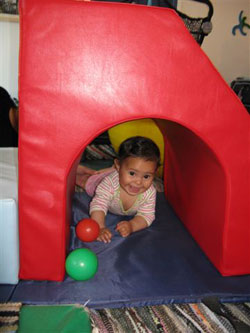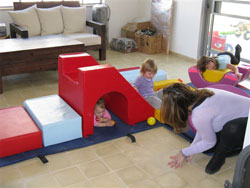3-6 month
Recommended exercises for ages 3 – 6 months:
Balls pool
Lay the baby inside the balls pool on its
back or on its stomach according to the following option
Ages 0-3 months: no balls in the pool/ few balls in the pool/
with a soft toy/ with a ball at the rim of the pool.
Ages 3-6 months: more balls can be placed in the pool.
Exercise No. 1
Take a ball from the pool and gently move it along the
outline of the baby’s body, while naming each body part as
the ball touches it.
Exercise No. 2
Let the baby feel the ball/ catch it/ move it from one hand to
the other – according to the baby’s stage of development.
Exercise No. 3
Show the baby how you roll the ball; let it follow the ball as it
rolls.
Exercise No. 4
Let the baby lie in the pool in different positions and study
the environment – play soft and soothing music and
maintain eye contact with the baby.
Exercise No. 5
Ages 3-6 months: while the pool is filled with balls, lay the
infant on its back and move it gently on the balls back and
forth and from side to side.
Exercise No. 6
Ages 3-6 months: lay the infant on its stomach on the slide
with its head towards the pool; hold it and encourage it to
play with the balls with its hands. Repeat the same
exercise, this time with the infant’s legs towards the pool
and playing with its feet.
Developmental contribution:
Familiarity with the outline of the body, familiarity with the
environment, the pool and the balls create motion sensation
and senses stimulation that help developing rolling over and
crawling skills in the future. Following a ball as it moves,
catching it and later rolling it, help the development of eye –
hand coordination.
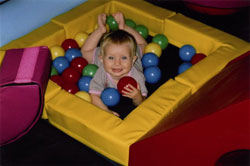
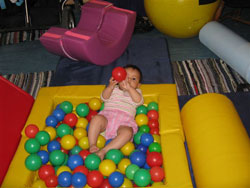

Various accessories for balance
A seesaw made from two pink half circles and yellow
half cylinder/ yellow half cylinder/ blue half cylinder
Exercise No. 1
Lay the baby on its back or on its stomach, and rock it
gently. Change the baby’s position while checking in which
position it is most comfortable.
Exercise No. 2
Give the baby a ball to hold / encourage the baby to grab
the ball by itself.
Exercise No. 3
Lay the baby on its stomach and place the ball in front of its
eyes/ let the baby follow the ball while gently rocking it.
Balancing plane
Exercise No. 4
Lay the baby on its back or on its stomach and rock it gently
while changing positions. If you feel that the baby likes
being rocked, you can rock it while changing speed and
sudden stops.
Exercise No. 5
Rock the baby gently up and down and in circular motions.
Exercise No. 6
Gently insert the small red cylinder under the baby’s thorax;
this will encourage the infant to raise its head and
strengthen its neck muscles and shoulder girdle.
A seesaw combining the two pink semi circles
Exercise No. 7
Lay the baby on its back, (could be done in a cradling
motion) and rock it gently.
Developmental contribution
Balancing skills are important to the development body
control sensation, and are necessary for rolling over
efficiently and later for crawling correctly and orderly until
the transition to sitting, standing and walking. Balancing
exercises require the babyto stabilize and hence
contributing to achieve a balanced muscle tonus. Lying on
the stomach in different positions encourage the baby’s
motion development. Raising the head helps strengthening
the baby’s neck muscles and shoulder girdle. Different
babies like different balancing positions, try to find the
feature that the baby feels most comfortable in and continue
to introduce it to the other features. Diversify the exercises
for the baby.
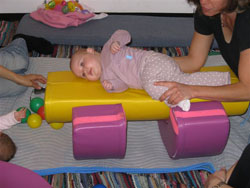
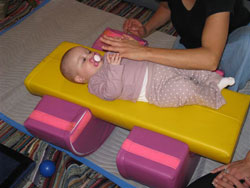
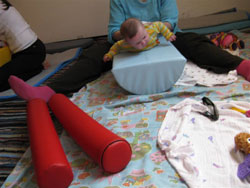

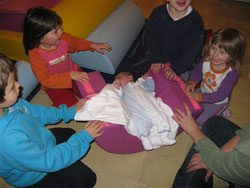
Cylinder/ half cylinders - from 3 months onwards
Exercise No. 1
lay the baby on the cylinder, its thorax and stomach
touching the cylinder; move the baby back and forth so that
its weight rests on its hands and then back on its knees.
Exercise No. 2
lay the baby on the cylinder and roll it back and forth. Place
toys in different distances from the cylinder so that the baby
will reach out for the toys and grab them.
Exercise No. 3
Some babies need more maneuvering space. Place the
smaller blue semi circle on top of the bigger yellow one. In
this position place the baby on the smaller blue semi circle
and rock it gently. Perform this exercise both with the baby
lying at the center of the cylinder and on different sides to
practice leaving one hand (a different hand each time).
Exercise No. 4
lay the baby in front of the cylinder and encourage it to
push and to knock the cylinder over with its feet.
Developmental contribution
Exercises that include lying on the stomach develop the sensation in the areas at the front of the body (the belly, the chest and the thorax).
Developing this sensation is very important and encourages motion development, weight transfer motions is preparation for standing on hands and knees before crawling and strengthening the shoulder girdle. Strengthening the shoulder girdle is very important for the Moro reflex. This reflex takes effect when the baby losses its balance.
The baby learns that in situations when its head is moving downwards it should spread its hands to the sides to prevent falling.
If the baby does not spread out its hands (in a cushioning motion) the exercise should be repeated several times until the infant clearly learns to connect between receiving the information and the reaction.
The different cylinders allow personal adjustment to every baby, to practice weight shifts from side to side.

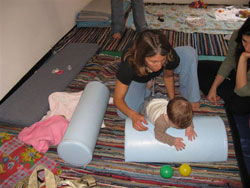

Slide (slope)
Exercise No. 1
Sit on your knees at the bottom of the slope, and place the
baby on his hand and knees on the slope with its head on
the top and its legs at the bottom of the slope, with its
sheens resting on and supported by your legs. Hold the
baby at the pelvis area and help the baby gently to move
back and forth. This motion is performed better and easier
on the slope than on the ground because gravity helps the
baby to move. The baby learns the move and after several
repetitions can perform it on its own. This movement helps
with the transition to crawling on hands and knees.
Exercise No. 2
Using the same position as in exercise No. 1 roll a ball
down from the top of the slope. At first the baby will watch
and follow the ball, later it will try to catch it.
Exercise No. 3
lay the baby on the top ramp of the slide, and move it
slowly and gently forward until it rests on its hands. Hold
the baby under its stomach and lift its entire body except of
its hands so that it reaches wheelbarrow stand (very
important for strengthening the shoulder girdle).
Exercise No. 4
lay the baby next to the slide, by the tunnel, and gently roll
balls towards the baby through the tunnel.
Exercise No. 5
lay the baby on the top ramp of the slide, and give it a ball
to hold and to roll down the slope to the balls pool.
Developmental contribution
Develops the sensation in the front areas of the body,
encourages motion development, weight transfer motions
as preparation for standing on hands and knees before
crawling and strengthening the shoulder girdle and Moro
reflex. Following the balls develops the baby’s eye – hand
coordination.
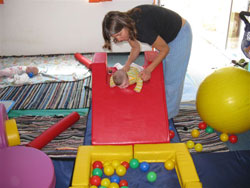
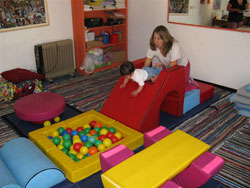

Peek- a- boo games
Play peek a boo with the baby in different places and using
different features of the GYMBOX mattress. The baby
follows you and tries to find out where the peek a boos
are coming from.
Exercise No. 1
Sit in front of the baby and use hide your face with the
cylinder. Peek and call the baby alternatively.
Exercise No. 2
lay the baby next to the slide, by the tunnel, and hide
behind the slide. Peek and call the baby alternatively.
Exercise No. 3
Attach the two pink half circles together to make a whole
circle (hoop). Hide your face behind it and peek from the
hole (peek a boo).
Developmental contribution
Peek -a -boo is known as babies’ first social game. The
baby enjoys a repetition game in which the significant adult
disappears and re-appears. Playing this sort of games the
baby learns the first social rules: dialogue, asking “peek –a-
boo” the baby learns to wait and then to receive the
answer, “boo”. Playing peek- a- boo help developing
circular motion – rotations, (in which some part of the body
is moving relatively to the rest of the body), when the baby
turns around to look for the parent. In the first months of
the baby’s life it moves its entire body as a bulk, and
separating the movements of different body parts is
essential to refine the movement and to make it effective.
In order to crawl, to sit, to stand and to walk successfully
the child must learn to separate the different body
movements and not to move the body as a whole. ,
.
